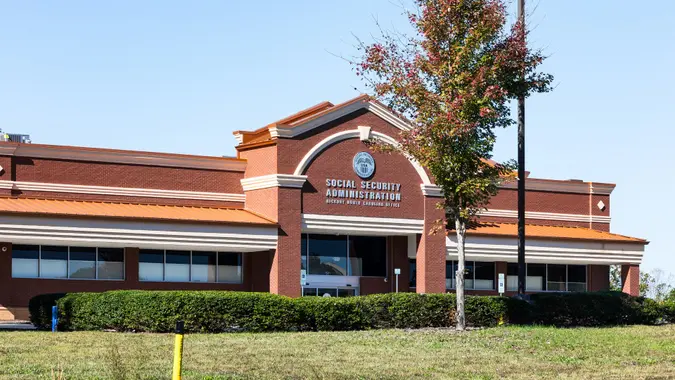6 Social Security Changes Experts Predict Could Come in the Next Decade

Commitment to Our Readers
GOBankingRates' editorial team is committed to bringing you unbiased reviews and information. We use data-driven methodologies to evaluate financial products and services - our reviews and ratings are not influenced by advertisers. You can read more about our editorial guidelines and our products and services review methodology.

20 Years
Helping You Live Richer

Reviewed
by Experts

Trusted by
Millions of Readers
Social Security is a lifeline for millions of Americans, but experts warn that the program faces serious financial challenges in the years ahead. Lawmakers are under growing pressure to act as the trust fund’s reserves are projected to run short in the early 2030s, per Social Security trustees report.
“The most significant reforms that have been discussed for years include raising the full retirement age, modifying the payroll tax cap, adjusting the benefit formula, and revising the cost-of-living adjustment (COLA),” said Shannon Benton, executive director of the Senior Citizens League. Below we dive into some of these possible social security changes.
Raising the Full Retirement Age (FRA)
One of the most likely Social Security changes is raising the full retirement age, which is the age when Americans can claim full benefits. According to the Congressional Budget Office, the full retirement age is already set to rise to 67 for workers born after 1959, and several proposals would gradually increase it to 68, 69 or even 70 for future retirees. This move is seen as a way to account for longer life spans and to help shore up Social Security’s finances.
However, raising the FRA would mean that many future retirees would have to wait longer to receive full benefits. “Delaying full benefits would effectively reduce lifetime benefits for many retirees who claim benefits early, particularly those unable to continue working into their late 60s,” Benton explained.
Modifying the Payroll Tax Cap
Another major reform under discussion is modifying or eliminating the payroll tax cap, which limits the amount of income subject to Social Security taxes. According to Benton, only earnings up to $168,600 are currently taxed for Social Security, leaving higher earners’ additional income untaxed.
Proposals like Congressman John Larson’s Social Security 2100 Act would apply payroll taxes to wages above $400,000, creating what’s known as a “donut hole.” This means income between the current taxable cap and $400,000 wouldn’t be taxed for Social Security, but income above that threshold would. Over time, as the cap rises, this gap would close and all high earnings would be subject to Social Security taxes.
Adjusting the Benefit Formula
Adjusting the Social Security benefit formula is another reform that could be enacted to improve the program’s solvency and equity. The current formula is progressive, replacing a higher percentage of income for lower earners and less for higher earners. “Some plans propose reducing benefits for higher earners while modestly boosting them for lower-income beneficiaries,” Benton said.
For example, the Bowles-Simpson plan would cut benefits for high earners and boost them for low earners, according to the Tax Foundation. These changes aim to provide greater income security for the most vulnerable retirees while reducing costs for the system as a whole.
Revising the Cost-of-Living Adjustment (COLA)
The way Social Security benefits are adjusted for inflation could also see significant changes in the next decade. “One recurring proposal is to adopt the Chained CPI, which tends to produce lower inflation estimates than the current CPI-W used for COLAs,” Benton explained. Critics argue this would erode retirees’ purchasing power over time, especially for those who live longer.
Alternatively, Benton and The Senior Citizens League support using the Consumer Price Index for the Elderly (CPI-E), which better reflects seniors’ spending patterns and would likely result in higher COLAs. The debate centers on balancing the need for program solvency with protecting retirees’ standard of living.
Increasing the Payroll Tax Rate
A gradual increase in the payroll tax rate is another option experts believe could help close Social Security’s funding gap. According to the Social Security Administration, the current rate is 6.2% for employees and 12.4% for the self-employed, split between workers and employers. “Even a small increase, phased in over time, could significantly improve solvency,” Benton said. This solution spreads the cost across all workers and helps ensure Social Security’s future without drastic benefit cuts.
Taxing Benefits More Heavily
Benton predicts that changes to how Social Security benefits are taxed could be on the horizon, particularly for higher-income retirees. The Concord Coalition reported that up to 85% of benefits can be taxed depending on income. However, the income thresholds are not indexed to inflation, so more beneficiaries are taxed each year.
Proposals include lowering the income thresholds or increasing the share of benefits subject to taxation for higher earners. This would raise additional revenue for the trust fund and target those most able to afford it. However, such changes could be unpopular among middle- and upper-income retirees, making them politically sensitive.
More From GOBankingRates
 Written by
Written by  Edited by
Edited by 
























